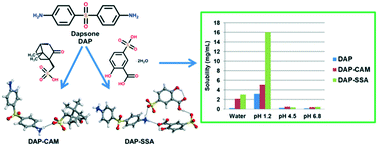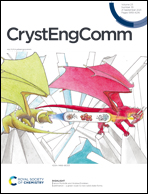New insight into improving the solubility of poorly soluble drugs by preventing the formation of their hydrogen-bonds: a case of dapsone salts with camphorsulfonic and 5-sulfosalicylic acid†
Abstract
Improving the solubility of poorly soluble drugs has always been a challenging subject in the field of medicine. In this regard, a pharmaceutical cocrystal strategy has been considered to be an effective way. Dapsone (DAP) is nowadays a first-line drug for the treatment of leprosy and is also effective in the treatment of dermatoses, malaria and other AIDS-related diseases. However, because of its low aqueous solubility, the high oral doses required and associated side effects limit the tolerability and efficacy of a dapsone free base. Herein, two drug salts of dapsone with sulfonic acid, namely, dapsone–camphorsulfonic acid (1 : 1) and dapsone–5-sulfosalicylic acid (1 : 2), abbreviated as DAP–CAM and DAP–SSA respectively, have been readily obtained and investigated. DAP–CAM and DAP–SSA shows the highest solubility in the buffered solution at pH = 1.2, which are both higher than DAP itself. In addition, the solubilities of both salts are 9.3 and 13.2 times that of DAP in water, respectively, which shows the highest improvement among the reports so far. The improved solubility of these two DAP salts is closely related to their structures, such as the anion–cation interactions and hydrogen bonds. The formation of N–H⋯O![[double bond, length as m-dash]](https://www.rsc.org/images/entities/char_e001.gif) S interactions between the aromatic amino groups and sulfonyl groups of DAP molecules is considered to disfavor the solvation of the DAP adducts. By introducing sulfonic acids, such as camphorsulfonic acid and 5-sulfosalicylic acid, the formation of the main hydrogen bonding N–H⋯O
S interactions between the aromatic amino groups and sulfonyl groups of DAP molecules is considered to disfavor the solvation of the DAP adducts. By introducing sulfonic acids, such as camphorsulfonic acid and 5-sulfosalicylic acid, the formation of the main hydrogen bonding N–H⋯O![[double bond, length as m-dash]](https://www.rsc.org/images/entities/char_e001.gif) S interactions between DAP molecules can be prevented, thus enhancing the solubility of DAP.
S interactions between DAP molecules can be prevented, thus enhancing the solubility of DAP.

- This article is part of the themed collection: Crystal Engineering Techniques


 Please wait while we load your content...
Please wait while we load your content...